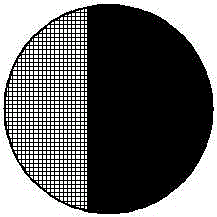A short-distance nitrification-denitrification biomembrane denitrogenation method for nitrogen containing sewage
A short-range nitrification and biofilm technology, which is applied in the field of short-range nitrification and denitrification biofilm denitrification, can solve the problems of large area and achieve fast film formation and good denitrification effect
- Summary
- Abstract
- Description
- Claims
- Application Information
AI Technical Summary
Problems solved by technology
Method used
Image
Examples
Embodiment 1
[0040] 1. Film-hanging stage
[0041] (1) Dilute the nitrogenous sewage to be treated twice with domestic sewage. After dilution, the concentration of ammonia nitrogen in the sewage is 250mg / L, the concentration of COD is 400mg / L, the pH value of the sewage is controlled to be 7.5-8.5, and the treatment temperature is 30-35 ℃, add glucose and potassium dihydrogen phosphate to adjust BOD in wastewater 5 :N:P=100:5:1.
[0042] (2) Fill the corresponding fillers in the hydrolytic acidification zone, aerobic zone and anaerobic zone, so that the volume of the fillers accounts for 3 / 4 of the volume of each reaction zone, and the activated sludge is filled according to the sludge concentration of 5-10g / L Sprinkle it into the filler in the three reaction zones. Palladium-copper loaded activated carbon catalyst particles are loaded in the transition zone, and the volume accounts for about 3 / 4 of the volume of the transition zone.
[0043] (3) Open the water inlet pipe, adjust the wa...
Embodiment 2
[0051] use figure 1 The shown biofilm denitrification reactor is used to treat the same nitrogen-containing sewage as in Example 1.
[0052] When starting the reactor, first use the low flow rate to operate, according to the flow rate of H m / h, that is, control the residence time of sewage to 60min. Detect the concentration of COD, total nitrogen and ammonia nitrogen in the effluent every 30 minutes; after 150 minutes, the concentration of COD in the effluent <150mg / L, the concentration of ammonia nitrogen <80mg / L, and the concentration of total nitrogen <100mg / L are relatively stable, and then increase the flow rate to 6 / 5Hm / h, detect the concentration of COD, total nitrogen and ammonia nitrogen in the effluent every 20 minutes; after 80 minutes, the concentration of COD in the effluent <70mg / L, the concentration of ammonia nitrogen <40mg / L, the concentration of total nitrogen <50mg / L and relatively stable , increase the flow rate to 3 / 2Hm / h again, and detect the concentrati...
Embodiment 3
[0055] use figure 1 The shown reactor handles the same nitrogenous sewage as in Example 1. The difference is that the nitrous bacteria growth promoter is added in the hydrolytic acidification area of the film-hanging stage and the sewage treatment stage. The nitrous bacteria growth accelerator involved can be prepared according to the methods described in CN201410585655.X, CN201410585481.7, etc., and two types of nitrifying bacteria growth accelerators are prepared according to the ratio and formula of the accelerator in Table 1, and the concentration of the accelerator is Both are 0.5g / L.
[0056] Table 1 Formula and ratio of accelerator
[0057]
[0058] Add nitrous bacteria growth promoter A in the film forming stage, and the dosage is based on the accelerator concentration of 25mg / L in the sewage treatment system. After culturing, the film-hanging stage only needs 70h.
[0059] Add nitrous bacteria growth accelerator B in the film-hanging stage, and the dosage is ...
PUM
| Property | Measurement | Unit |
|---|---|---|
| particle diameter | aaaaa | aaaaa |
Abstract
Description
Claims
Application Information
 Login to View More
Login to View More - R&D
- Intellectual Property
- Life Sciences
- Materials
- Tech Scout
- Unparalleled Data Quality
- Higher Quality Content
- 60% Fewer Hallucinations
Browse by: Latest US Patents, China's latest patents, Technical Efficacy Thesaurus, Application Domain, Technology Topic, Popular Technical Reports.
© 2025 PatSnap. All rights reserved.Legal|Privacy policy|Modern Slavery Act Transparency Statement|Sitemap|About US| Contact US: help@patsnap.com



